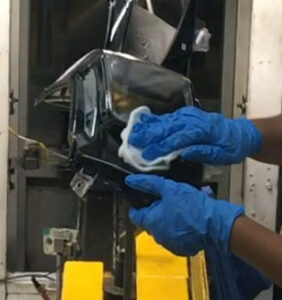by Dr. Nelson Sorbo, vice president of R&D, Cool Clean Technologies
When it comes to plastic parts, manufacturers and decorators strive to produce the highest quality products. As a result, when it comes to processes such as painting and coating, making sure all parts are free from contaminants that could dimmish the final product is essential.
Plastics Decorating recently sat down with Dr. Nelson Sorbo of Cool Clean Technologies to discuss the most efficient ways to clean plastic surfaces as well as the latest technologies for surface decontamination.
Why is it important to clean surfaces prior to painting/coating?
The critical importance of clean surfaces in the painting/coating process often is overlooked as parts can “look” clean, but the surface contaminants may be invisible to a casual visual inspection. Having a reliable and consistent cleaning solution is essential to produce a product with a longer-lasting and high-quality surface finish. Effective painting/coating operations require the surfaces be cleaned so that the paint/coating can properly adhere to the surface.
What are the potential consequences of not cleaning properly?
The result of an improper/ineffective cleaning process prior to the painting/coating process will lead to poor adhesion of the paint, resulting in a variety of flawed surface finish issues. Cleaning failures on the part normally can be discovered early in the coating process. Parts with coating surface flaws, such as bubbling or streakiness, then become scrap.
In some cases, a poor surface treatment may not be visible immediately but may become apparent when exposed to environmental impacts of heat, moisture, UV or slight abrasion. In these cases, the parts are considered “returns.”
How do decorators know if a part is “clean”?
This basic question is difficult to answer. There are generally three types of cleaning metrics: visual, analytical and functional.
Visual cleaning metrics are the most obvious and easiest to understand. If contamination is visually identified, the part clearly is not clean. This evaluation frequently is conducted by examination under a bright light (white light, UV black light) by the technician and can be augmented by projecting the light at an angle to better illuminate any contamination present.
Another visual metric is the use of the “white glove” test in which a white cloth is drawn across the cleaned part’s surface to visibly show any remaining residue on the cloth. Both techniques are effective and easily applied.
Analytical cleaning metrics use various technologies to assess the state of the part surface, frequently as microscopy and laser-based surface scans. Other types of cleanliness evaluations, such as water break/goniometer, dyne pen and breath tests, also may be used to determine surface cleanliness.
Functional testing involves evaluating the state of cleanliness based on how functionally robust the coating/paint adheres to the surface. Apart from the visual examinations stated above, two common tests used to evaluate the effectiveness of the coating – and indirectly, the quality of surface cleaning – are the cross hatch and thermal shock tests.
Each of these tests involves examining the durability of the coating applied to the part’s surface by thermal stress or surface abrasion metrics.
How do decorators decide the best/most appropriate cleaning method?
The first set of cleaning options are those that can effectively remove the residues of interest from the parts to be coated. Ultimately, this depends on the contamination on the surface, the surface geometry and the applicable cleanliness metric.
From that set of cleaning options, candidate cleaning solutions must be evaluated based on compatibility with existing manufacturing processes, cleaning system footprint and installation – such as facilities requirements, operation, and maintenance costs and capital costs. The following are candidate cleaning technologies for plastics cleaning applications:

Hand wiping: One of the most common methods used for cleaning prior to coating is hand wiping parts with a rag and a solvent, typically an alcohol. While conceptually very simple, the primary issue is the inconsistency with how each operator cleans the parts. As the parts come down the line, the operator is forced to quickly wipe the part when it arrives. This can force the operator to use the same rag to clean multiple parts or rely on inadequate and inconsistent quantities of alcohol on the rag.
Furthermore, effective hand wiping requires a level of physical exertion by the operator, as well as following mundane cleaning techniques. Studies have shown that this method can generate inconsistent, operator-specific cleaning results, which make it difficult to accurately develop production plans.
Although this option can be the easiest solution to implement, the overall labor, rags and solvent waste, coupled with inconsistent cleaning results, may result in more company costs. Further, these flammable solvents can impact worker safety and many companies are trying to eliminate them from their manufacturing processes.
Air blow off: There are other methods that can help deliver more reliable results. Air knives or blow off systems have been used to remove surface contamination. Although very effective for large particle or fiber cleaning applications, air knife cleaning systems are ineffective for removing small particles and other non-particulate residues from the surface of the parts.
In some cases, mechanical feather dusters are used to enhance the air blow off systems. The mechanical cleaning of a feather duster is much more effective in removing small particles but has been known to spread contamination around, leaving the resulting surface unclean.
Aqueous cleaners: Aqueous, or water-based, cleaning systems have proven successful at removing various types of contamination from the surface of parts. They have been recommended by automotive manufacturers and other automotive original equipment managers (OEMs) for their surface preparation requirements.
A major drawback to this cleaning solution is the high capital costs and large footprint requirement, which puts stress on smaller tier suppliers of parts. Aqueous cleaning is capable of cleaning multiple parts at once, but all parts need to go through a drying process to avoid water spots that affect paint adhesion. The use of aqueous-based cleaning systems necessitates the operator to manage the quality of water and the maintenance of the cleaning chemistry used in the process.
Although properly maintained aqueous-based systems are effective cleaning systems, their high energy requirements for drying and excessive wastewater management issues create a larger environmental burden than other cleaning systems.
CO2 spray cleaning: The newest surface cleaning technology is automated CO2 spray cleaning.
The CO2 spray consists of solid CO2 crystals, known in the industry as snow, propelled by compressed air to impact the surface and clean various parts. Upon striking the surface of the part, the CO2 particles remove and entrain the residue in exhaust gas and duct it away from the cleaning zone. Hence, there is no cleaning residue (no solvent, no water) or cleaning implements (no rags) to manage with this cleaning process.
The CO2 spray system generates a cleaning spray through nozzles that are actuated across the part, much like the paint spray process.
Requirements for installation of a CO2 spray system include automated nozzle actuation, source of clean compressed air, a supply of beverage-grade CO2 and ventilation for the cleaning station.
What are the benefits of using CO2 cleaning technology?
There are numerous benefits to using CO2 spray cleaning technology over existing alternatives. The fundamental benefit of CO2 spray cleaning is that it provides a no-touch, non-abrasive and “dry” cleaning solution that uses standard automation found in most plastics manufacturing facilities. CO2 cleaning provides outstanding residue removal capability with operating costs as low as 80% less than competing aqueous-based cleaning systems.
The CO2 spray cleaning system is designed to be a small-footprint, “drop-in” cleaning solution frequently positioned in the existing paint line immediately before the primer/hard coat process. And, the use of recycled CO2 provides an environmentally friendly, energy-efficient cleaning solution for all plastics cleaning applications.
What are some of the requirements of CO2 technology?
Because this technology is a spray technology, each nozzle must be directed at the surface to be cleaned. Hence, the cleaning nozzles must be actuated to appropriately cover all areas of the part.
Furthermore, the environment in which the parts are cleaned must be well ventilated to inhibit residue redeposition on cleaned parts. Fortunately, most plastics manufacturing operations already have robotic automation and ventilation systems within their facilities, so this is not a large problem.
Finally, this technology requires a CO2 supply, which is not typically found in plastics manufacturing operations. However, as CO2 spray systems use beverage-grade CO2, the supply is readily accessible and available throughout the world.
What role does CO2 technology play with sustainability goals/trends?
Manufacturers and customers are becoming more conscious of climate change concerns, and CO2 has played a role in this concern. While CO2 spray cleaning technology certainly uses CO2, the CO2 used is recycled – meaning it has been captured, purified, packaged and sold to processes requiring CO2, such as food/beverage manufacturers, low-temperature cooling requirements, welding gas and other uses.
Because all the CO2 used for spray cleaning systems is recycled, the spray cleaning systems do not contribute any additional CO2 to global emissions budgets.
Further, because CO2 spray cleaning is a dry cleaning solution, there is no electricity or gas consumption required to dry the parts. As all gas drying and most electric drying systems use electricity from fossil fuel sources, the use of CO2 spray systems can reduce CO2 emissions to the environment compared to aqueous-based cleaning systems.
 Dr. Nelson Sorbo has more than 30 years of experience in a wide range of research, development and project management areas. At Cool Clean, Sorbo has directed the design and manufacturing of numerous automated CO2 spray cleaning systems that have been installed worldwide. He also has worked on developing the dense phase CO2 process technology for extraction of botanicals, sterilization, garment cleaning, precision cleaning and degreasing. Currently, he serves as vice president of research and development and supports all Cool Clean Technologies programs in Asia. For more information, contact Sorbo at [email protected] or visit www.coolclean.com.
Dr. Nelson Sorbo has more than 30 years of experience in a wide range of research, development and project management areas. At Cool Clean, Sorbo has directed the design and manufacturing of numerous automated CO2 spray cleaning systems that have been installed worldwide. He also has worked on developing the dense phase CO2 process technology for extraction of botanicals, sterilization, garment cleaning, precision cleaning and degreasing. Currently, he serves as vice president of research and development and supports all Cool Clean Technologies programs in Asia. For more information, contact Sorbo at [email protected] or visit www.coolclean.com.





